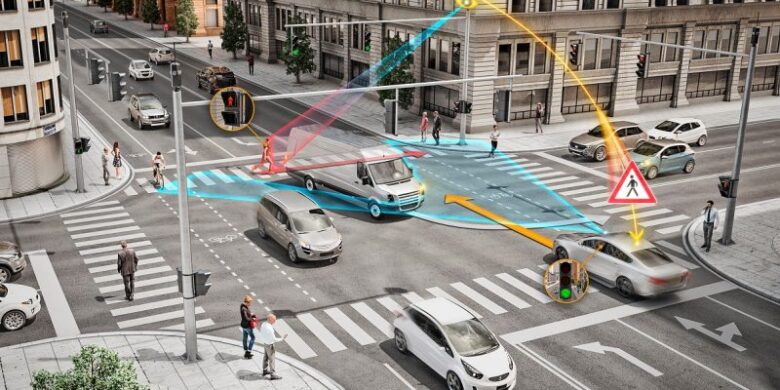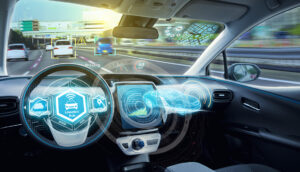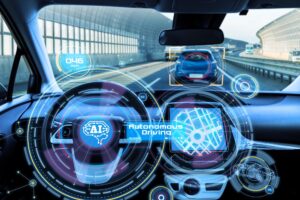The current world of technology is changing rapidly, and at the center of this change is the idea of intelligent cities. They are urban areas that are constructed with integrated technology that improves the infrastructure, services, and general quality of living. As smart cities grow, one of the major elements that will transform urban mobility is the introduction of autonomous vehicles. These autonomous vehicles that are driven by AI and live information will soon be the mainstay of the way people move in the coming cities. Their function for smart urban areas will extend beyond just convenience. They will play an essential role in the creation of sustainable, efficient, safe, and effective transportation systems.
Connectivity as the Foundation of Integration
To enable autonomous vehicles to operate effortlessly in cities with smart technology, connectivity will be an essential component. They rely on continuous interaction with their environment to make quick decisions. Smart cities equipped with advanced communication networks like 5G and vehicle-to-everything (V2X) technology will enable autonomous vehicles to interact not only with traffic lights and road signs but also with other vehicles and infrastructure. This kind of connectivity allows real-time sharing of information on traffic patterns and road conditions as well as potential dangers, which will assist in optimizing traffic flow and reducing the risk of accidents. The development of autonomous cars will consequently rely heavily on an infrastructure of digital technology that allows for continuous information exchange as well as coordination.
The Role of Artificial Intelligence in Urban Navigation
Artificial intelligence is the main brain that powers autonomous vehicles. Smart cities will be smarter because AI is essential to assist these vehicles in navigating complicated urban landscapes. By recognizing traffic signals, pedestrian crossings, and making decisions in fast-paced environments, AI will enable vehicles to make informed choices and operate securely. As cities get more intelligent, the data gathered from the thousands of sensors located there will be fed directly into AI systems, increasing their ability to learn and predict. The symbiosis between intelligent cities and AI-powered vehicles implies that the more intelligent and connected cities become, the safer and more efficient automated vehicles are inside the city.
Impact on Urban Mobility and Public Transportation
The integration of autonomous vehicles in smart cities will transform urban mobility. Public transport will no longer rely solely on trains and buses. Instead, a fleet of autonomous shuttles and ride-sharing vehicles can enhance existing systems by creating gaps and providing flexible transportation choices. The self-driving cars can be arranged on demand, reducing waiting times and making commutes easier. The integration will also facilitate first- and last-mile options, which will allow users to seamlessly travel from their home to public transport hubs as well as the final destination. Everyone, including seniors and disabled people, can expect a more effective, customized, and accessible mobility experience in smart cities.
Reducing Traffic Congestion Through Intelligent Systems
Traffic congestion is among the most significant challenges faced by cities, resulting in reduced time, more pollution, and a decrease in productivity. The incorporation of automated vehicles in smart city infrastructure offers the chance to solve the problem. Through real-time communications and AI-driven routing optimization, vehicles that are autonomous will be able to reduce congestion and spread traffic more evenly throughout the roads. Additionally, since autonomous vehicles are able to control their surroundings, they are able to make more efficient and tighter traffic flow, which reduces the stop-and-go patterns that cause congestion. The synchronization of vehicles and smart infrastructures can result in a smoother flow of traffic, less consumption of fuel, and better utilization of roads in cities.
Environmental Benefits and Sustainable Urban Living
One of the primary objectives for smart city development is sustainable living, and autonomous vehicles could aid in this aim. The majority of autonomous vehicles are likely to be electric, which will help in reducing carbon dioxide emissions and pollution in the air. Integrating autonomous vehicles into an intelligent city that utilizes renewable energy sources can further enhance its positive environmental impact. Furthermore, autonomous vehicles can reduce the total number of vehicles on the roadway by using shared mobility services. This means fewer cars taking up urban areas, less need for parking spots, and more room for pedestrian and green zones. The move toward electric, autonomous, and shared cars aligns perfectly with the goal of sustainable and eco-friendly cities.
Changes in City Infrastructure and Urban Design
The incorporation of autonomous vehicles in intelligent cities is going to require adjustments to the way cities are planned and constructed. In particular, with less need for street parking, vast urban areas could be repurposed into bicycle lanes, parks, or housing. The roads could also be shorter as self-driving vehicles are able to be more precise and need less space between lanes. Furthermore, smart infrastructure, like intelligent traffic signals as well as dynamic lane markings and dedicated laneways for autonomous vehicles, will be commonplace. These changes to infrastructure are not just a way to support technology but will also result in the appearance of more appealing and functional urban environments.
Enhancing Safety and Reducing Accidents
Safety is among the main benefits of integrating autonomous cars in smart urban areas. Human error is at the root of the majority of road accidents, but autonomous vehicles are made to follow traffic regulations strictly and respond faster than human beings. Constant communication between vehicles and infrastructure enables the identification and mitigation of dangers before they cause harm. For instance, when a pedestrian is walking across the street and is not in sight, a sensor nearby might alert a vehicle approaching to slow down in the appropriate time. The increased awareness and coordination can make streets safer for everyone, which includes cyclists, pedestrians, and other drivers.
Conclusion
The incorporation of automated vehicles in smart urban areas is significant progress in urban development. The combination of autonomous technology and intelligent infrastructure is expected to improve the safety of cities and make them cleaner and more productive. Despite the challenges of infrastructure improvements, regulatory alignment, and data security, the advantages are substantial. From reducing congestion in traffic and carbon emissions to transforming the urban landscape and improving mobility for everyone, autonomous vehicles are set to be a crucial element of the intelligent city system. As technology develops and urban areas continue to adopt innovations, the road toward smooth integration becomes clearer and more feasible.
FAQs
1. What obstacles are there for the integration of autonomous vehicles into cities?
There are challenges to overcome, such as the upgrading of infrastructure, creating security and regulatory frameworks, and ensuring public trust and the privacy of data.
2. What are the implications for public transportation? get affected?
Autonomous vehicles will enhance public transport by offering first- and last-mile connectivity, as well as customizable on-demand services.
3. Autonomous vehicles will help make roads safer?
Autonomous vehicles will reduce accidents by minimizing human error in driving and utilizing modern safety technologies.
4. Who is benefiting from the integration of autonomous vehicles?
Everyone living in cities can gain from reduced commute times to planners who are able to create more efficient urban spaces.
5. When will we see the complete autonomous vehicles fully integrated into cities?
Although limited integration is currently taking place, full-scale integration is likely to take 10–15 years, contingent on the progress of technology and policies.




